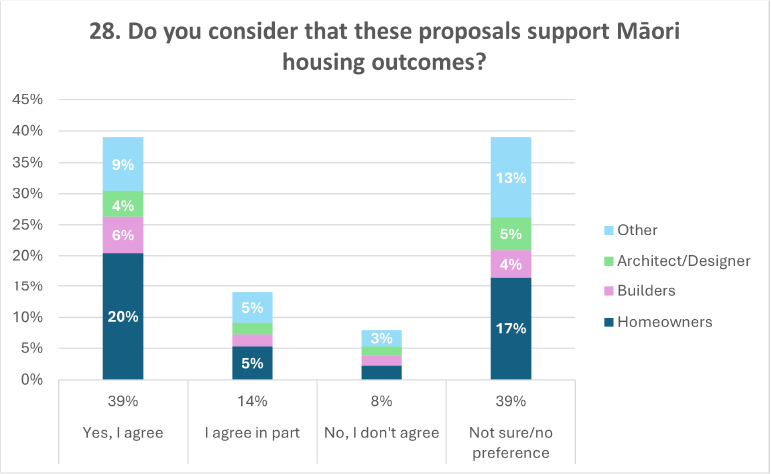Questions 28 and 29
On this page
What was proposed
The proposals under the Building Act and the Resource Management Act do not have specific provisions for Māori land, papakāinga or kaumātua housing. The proposals may go some way to addressing the regulatory and consenting challenges for developing on Māori land, and for papakāinga and kaumātua housing, where the circumstances of these proposals apply.
What was asked
Question 28: Do you consider that these proposals support Māori housing outcomes?
Question 29: Are there additional regulatory and consenting barriers to Māori housing outcomes that should be addressed in the proposals?
Figure 17: Graph detailing the response to question 28

Text description for graph - Figure 17: Graph detailing the response to question 28
Summary of feedback
In response to question 28, 1450 submissions were received, and 292 submitters provided a further explanation of their view, and 159 submitters provided a response to question 29. There was general support that the policy supports Māori housing outcomes to an extent.
A key theme identified in submissions was that the policy will reduce consenting costs, supply more housing and creates social and economic benefits for Māori.
A key risk identified in submissions was that this policy could exacerbate existing housing problems for Māori, including poor quality housing and health outcomes.
In relation to question 29, a key theme was the impacts of this policy on Māori housing are limited by both the limit of one granny flat per site and the minor residential unit definition not providing for multiple owners.
Another theme from submissions was that the key barriers are beyond the scope of the building and resource management systems. These barriers include funding and financing, requiring Māori land court orders to develop on Māori freehold land, and lack of infrastructure. A few submitters, especially councils, also considered that barriers to Māori housing would be better addressed through a separate mechanism. Several councils supported separate national direction for papakāinga.
Homeowners
There was some support that this policy would support Māori housing outcomes, especially regarding multi-generational living. Some homeowners considered if the policy was more enabling of tiny homes, this would also improve Māori housing outcomes.
Iwi, hapū and Māori
Iwi, hapū and Māori generally agreed that this policy would support Māori housing outcomes to an extent. To improve the outcomes through this policy alone, iwi, hapū and Māori considered the policy should apply to Māori purpose zones, enable more than one granny flat per site and enable people to build a granny flat on sites with multiple owners. Issues were raised around sewage, septic tanks and water tanks on rural land, and submitters requested that these are considered.
Councils
Councils generally considered Māori housing outcomes would be best addressed through papakāinga national direction and that many barriers exist outside of the building and resource management systems. Councils considered the limit of one granny flat per site would be a barrier to Māori housing. There was also concern from councils that the policy could exacerbate existing issues for Māori, including poor quality housing.
Industry
Some builders and architects/designers considered this policy could improve Māori housing outcomes if more than one granny flat is permitted per site.
There was support from planners that the policy supports Māori housing outcomes. However, planners considered the requirement to have a principal dwelling on a site (most papakāinga being in rural zones) and lack of infrastructure would be barriers to the success of this policy.
One architect/designer and the Disabled Persons Assembly Aotearoa considered it is important that universal design standards are considered through this policy to support elderly or disabled iwi, hapū and Māori.

